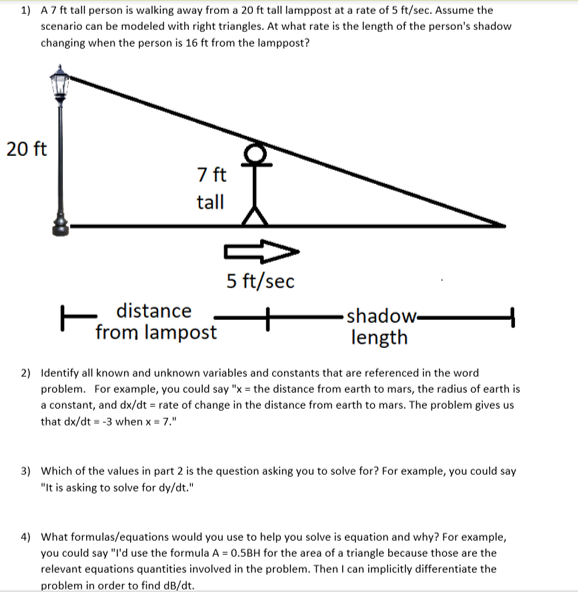1) A7 ft tall person is walking away from a 20 ft tall lamppost at a rate of 5 ft/sec. Assume the scenario can be modeled with right triangles. At what rate is the length of the person's shadow changing when the person is 16 ft from the lamppost? 20 ft 7 ft tall 5 ft/sec E distance from lampost shadow- length
1) A7 ft tall person is walking away from a 20 ft tall lamppost at a rate of 5 ft/sec. Assume the scenario can be modeled with right triangles. At what rate is the length of the person's shadow changing when the person is 16 ft from the lamppost? 20 ft 7 ft tall 5 ft/sec E distance from lampost shadow- length
Mathematics For Machine Technology
8th Edition
ISBN:9781337798310
Author:Peterson, John.
Publisher:Peterson, John.
Chapter59: Areas Of Rectangles, Parallelograms, And Trapezoids
Section: Chapter Questions
Problem 79A
Related questions
Question

Transcribed Image Text:1) A7 ft tall person is walking away from a 20 ft tall lamppost at a rate of 5 ft/sec. Assume the
scenario can be modeled with right triangles. At what rate is the length of the person's shadow
changing when the person is 16 ft from the lamppost?
20 ft
7 ft
tall
5 ft/sec
distance
from lampost
- shadow-
length
2) Identify all known and unknown variables and constants that are referenced in the word
problem. For example, you could say "x = the distance from earth to mars, the radius of earth is
a constant, and dx/dt = rate of change in the distance from earth to mars. The problem gives us
that dx/dt = -3 when x = 7."
3) Which of the values in part 2 is the question asking you to solve for? For example, you could say
"It is asking to solve for dy/dt."
4) What formulas/equations would you use to help you solve is equation and why? For example,
you could say "I'd use the formula A = 0.5BH for the area of a triangle because those are the
relevant equations quantities involved in the problem. Then I can implicitly differentiate the
problem in order to find dB/dt.
Expert Solution
This question has been solved!
Explore an expertly crafted, step-by-step solution for a thorough understanding of key concepts.
This is a popular solution!
Trending now
This is a popular solution!
Step by step
Solved in 2 steps with 1 images

Recommended textbooks for you

Mathematics For Machine Technology
Advanced Math
ISBN:
9781337798310
Author:
Peterson, John.
Publisher:
Cengage Learning,

Elementary Geometry for College Students
Geometry
ISBN:
9781285195698
Author:
Daniel C. Alexander, Geralyn M. Koeberlein
Publisher:
Cengage Learning

Elementary Geometry For College Students, 7e
Geometry
ISBN:
9781337614085
Author:
Alexander, Daniel C.; Koeberlein, Geralyn M.
Publisher:
Cengage,

Mathematics For Machine Technology
Advanced Math
ISBN:
9781337798310
Author:
Peterson, John.
Publisher:
Cengage Learning,

Elementary Geometry for College Students
Geometry
ISBN:
9781285195698
Author:
Daniel C. Alexander, Geralyn M. Koeberlein
Publisher:
Cengage Learning

Elementary Geometry For College Students, 7e
Geometry
ISBN:
9781337614085
Author:
Alexander, Daniel C.; Koeberlein, Geralyn M.
Publisher:
Cengage,

Trigonometry (MindTap Course List)
Trigonometry
ISBN:
9781305652224
Author:
Charles P. McKeague, Mark D. Turner
Publisher:
Cengage Learning

Algebra & Trigonometry with Analytic Geometry
Algebra
ISBN:
9781133382119
Author:
Swokowski
Publisher:
Cengage

Algebra: Structure And Method, Book 1
Algebra
ISBN:
9780395977224
Author:
Richard G. Brown, Mary P. Dolciani, Robert H. Sorgenfrey, William L. Cole
Publisher:
McDougal Littell